Modeling Local Scour around a Cylindrical Pier with Circular Collar with Tilt Angles (Counterclockwise around the Direction of the Channel Cross-Section) in Clear-Water
Abstract
:1. Introduction
- (1)
- the numerical modeling and setup, including the introduction of LES, the verification of the method used in this study, the model and parameters studied in this paper;
- (2)
- the results and discussion, including the characteristics of the local scour depth and the topography around the pier in each case and the characteristics and mechanism of the effects of the circular collar with tilt angles on local scour depth around a single cylindrical pier.
2. Numerical Modeling and Setup
2.1. Governing Equations of LES
2.2. Mode of Bed-Load Transport
- (1)
- Meyer, Peter and Müller
- (2)
- Nielsen
- (3)
- Van Rijn
- βMPM,i, βNie,i, and βVR,i are coefficients typically equal to 8.0, 12.0, and 0.053, respectively. cb,i is the volume fraction of species i in the bed material. It does not exist in the original equations but is added in Equations (6–8) to account for the effect of multiple species.
- θi is the local Shields parameter of species i in the bed material and can be computed based on the local bed shear stress, τ, as shown in Equation (9):where τ is calculated using the law of the wall and the quadratic law of bottom shear stress for 3D turbulent flow with consideration of bed surface roughness.
- Φi is the dimensionless bed-load transport rate and is related to the volumetric bed-load transport rate, qb,i, as shown in Equation (10):
- θ′cr,i is the modification of θcr,i for sloping surfaces to include the angle of repose. θcr,i is the dimensionless critical Shields parameter of species i in the bed material and can be computed using the Soulsby-Whitehouse equation, as shown in Equation (11):where d*,i is the dimensionless parameter and can be computed by Equation (12), in which ρi is the density of the sediment species i. ρf is the fluid density. di is the diameter. µf is the dynamic viscosity of the fluid. ‖g‖ is the magnitude of the acceleration of gravity g.At sloping interfaces, the packed sediment is less stable and is more easily entrained by fluid moving down the slope. Hence, θcr,i alters into θ′cr,I, as shown in Equation (13):where β is the angle of the slope of the bed, φi is the user-defined angle of repose for sediment species i, and ψ is the angle between the flow and the upslope direction. For flow directly up a slope, ψ = 0.
2.3. Physical Model Verification
2.3.1. Parameters of the Physical Model
2.3.2. Parameters of the Computational Domain
2.3.3. Result of Physical Model Verification
2.4. Parameters of the Model with Circular Collar with Different Tilt Angles
3. Results and Discussion
3.1. The Maximum Scouring Depth in Each Case
3.2. The Topography of Each Case
4. Conclusions
- At the scour equilibrium, Case 2 (θ = 0°) is the best for reducing the local scour depth, and it can reduce the maximum local scouring depth by about 10%. With the increases of the tilt angle, the effect on reducing the local scour depth decreases gradually and is even counterproductive.
- At the early stage of scouring, cases with a circular collar prove that the circular collar can reduce the scour depth significantly. The smaller the tilt angle is, the more obvious effect on the scouring depth reduction.
- When the tilt angle is less than 5°, the location of the maximum local scouring depth is around 90 to 115° (the angle is measured clockwise from the flow direction) on both sides of the pier. The location of the maximum scour depth is around −115° to 115° when the tilt angle is larger than 5°, and the range of the local scour depth that is close to the maximum local scouring depth increases significantly when the tilt angle increases.
- Compared to Case 1, the area of the scour hole expands downstream by about 1.5D and expands laterally by about 0.8D. The topography downwards the pier in 1.0D in cases with a circular collar is changed to siltation from scouring. The smaller the tilt angle is, the higher the siltation. The topography downwards the pier is changed from scouring to siltation with the increase of the tilt angle, and the shape of siltation changes from a long-narrow rectangle to an equilateral triangle, which is about 2.5D downwards from the front of the former siltation area.
Author Contributions
Funding
Institutional Review Board Statement
Informed Consent Statement
Data Availability Statement
Conflicts of Interest
References
- Breusers, H.N.C.; Nicollet, G.; Shen, H.W. Local scour around cylindrical piers. J. Hydraul. Res. 1977, 15, 211–252. [Google Scholar] [CrossRef]
- Melville, B.W.; Raudkivi, A.J. Flow characteristics in local scour at bridge piers. J. Hydraul. Res. 1977, 15, 73–380. [Google Scholar] [CrossRef]
- Gao, D.G. Road and Bridge Flood Damage Prevention; China Communications Press: Beijing, China, 2002. [Google Scholar]
- Hunt, E.B. Monitoring Scour Critical Bridges; Transportation Research Board: Washington, DC, USA, 2009; pp. 1–10. [Google Scholar]
- Yi, R.Y. Causes and Risk Analysis of Bridge Collapse Accidents. Maint. Manag. 2016, 4, 22–26. [Google Scholar]
- Melville, B.W. Local Scour at Bridge Pier Site. Ph.D. Thesis, School of Engineering, University of Auckland, Auckland, New Zealand, 1975. [Google Scholar]
- Chiew, Y.M.; Melville, B.W. Local scour around bridge piers. J. Hydraul. Res. 1987, 25, 15–26. [Google Scholar] [CrossRef]
- Melville, B.W.; Sutherland, A.J. Design method for local scour at bridge piers. J. Hydraul. Eng. 1988, 114, 1210–1226. [Google Scholar] [CrossRef]
- Melville, B.W. The Physics of Local Scour at Bridge Piers. In Proceedings of the 4th International Conference on Scour and Erosion (ICSE-4), Tokyo, Japan, 5–7 November 2008. [Google Scholar]
- Deng, L.; Cai, C.S. Bridge Scour: Prediction, Modeling, Monitoring, and Countermeasures-Review. Pract. Period. Struct. Des. Constr. 2010, 15, 125–134. [Google Scholar] [CrossRef] [Green Version]
- Negm, A.M.; Gamal, M.; Moustafa, Y.M.; Fathy, A.A. Optimal shape of collar to minimize local scour around bridge piers. In Proceedings of the Thirteenth International Water Technology Conference IWTC13, Hurghada, Egypt, 1 January 2009; pp. 1–13. [Google Scholar]
- Ardeshiri, A.M.; Mojtaba, S. Experimental Study on Lozenge Collar Affection in Reduce Amount of Scouring Around Bridge Piers. J. River Eng. 2014, 2, 7–11. [Google Scholar]
- Jahangirzadeh, A.; Hossein, B.; Shatirah, A.; Hojat Karami, S.N.; Shahaboddin, S. Experimental and Numerical Investigation of the Effect of Different Shapes of Collars on the Reduction of Scour around a Single Bridge Pier. PLoS ONE 2014, 9, e98592. [Google Scholar] [CrossRef] [PubMed]
- Chen, S.C.; Samkele, T.; Wu, T.Y.; Chan, H.C.; Chou, H.T. A Hooked-Collar for Bridge Piers Protection: Flow Fields and Scour. Water 2018, 10, 1251. [Google Scholar] [CrossRef] [Green Version]
- Roulund, A.; Sumer, B.M.; Fredsøe, J.; MicheIsen, J. Numerical and experimental investigation of flow and scour around a circular pile. J. Fluid Mech. 2005, 534, 351–401. [Google Scholar] [CrossRef]
- Abouzeid, G.; Mohamed, H.I.; Ali, S.M. 3-D numerical simulation of flow and clear water scour by interaction between bridge piers. J. Eng. Sci. 2007, 35, 891–907. [Google Scholar] [CrossRef]
- Esmaeili, T.; Dehghani, A.A.; Zahiri, A.R.; Suzuki, K. 3D numerical simulation of scouring around bridge piers (Case study: Bridge 524 crosses the Tanana River). World Acad. Sci. Eng. Technol. 2009, 34, 1028–1032. [Google Scholar]
- Huang, W.; Yang, Q.; Xiao, H. CFD modeling of scale effects on turbulence flow and scour around bridge piers. Comput. Fluids 2009, 38, 1050–1058. [Google Scholar] [CrossRef]
- Zhu, Z.; Liu, Z. Three-dimensional numerical simulation for local scour around cylindrical bridge pier. China J. Highw. Transp. 2011, 24, 43–48. [Google Scholar]
- Khosronejad, A.; Kang, S.; Sotiropoulos, F. Experimental and computational investigation of local scour around bridge piers. Adv. Water Resour. 2012, 37, 73–85. [Google Scholar] [CrossRef]
- Xiong, W.; Wang, J.; Ye, J. Effect of pier structures on local scour 3D development. J. Southeast Univ. (Nat. Sci. Ed.) 2014, 44, 155–161. [Google Scholar]
- Ahmad, N.; Bihs, H.; Kamath, A.; Arntsen, Ø.A. Three-dimensional CFD modeling of wave scour around side-by-side and triangular arrangement of piles with REEF3D. Procedia Eng. 2015, 116, 683–690. [Google Scholar] [CrossRef] [Green Version]
- Ghasemi, M.; Soltani-Gerdefaramarzi, S. The scour bridge simulation around a cylindrical pier using Flow-3D. J. Hydrosci. Environ. 2017, 1, 46–54. [Google Scholar]
- Alemi, M.; Maia, R. Numerical simulation of the flow and local scour process around single and complex bridge piers. Int. J. Civ. Eng. 2018, 16, 475–487. [Google Scholar] [CrossRef]
- Jia, Y.; Altinakar, M.; Guney, M.S. Three-dimensional numerical simulations of local scouring around bridge piers. J. Hydraul. Res. 2018, 56, 351–366. [Google Scholar] [CrossRef]
- Svsndl, P.; Suresh, K.N. Simulation of flow behavior around bridge piers using ANSYS–CFD. Int. J. Eng. Sci. Invent. (IJESI) 2018, 7, 13–22. [Google Scholar]
- Pang, A.; Skote, M.; Lim, S.Y. A numerical approach for determining equilibrium scour depth around a mono-pile due to steady currents. Appl. Ocean Res. 2016, 57, 114–124. [Google Scholar] [CrossRef]
- Hamidi, A.; Siadatmousavi, S.M. Numerical simulation of scour and flow field for different arrangements of two piers using SSIIM model. Ain Shams Eng. J. 2017, 9, 2415–2426. [Google Scholar] [CrossRef]
- Rodi, W. Comparison of LES and RANS calculations of the flow around bluff bodies. J. Wind Eng. Ind. Aerodyn. 1997, 71, 55–75. [Google Scholar] [CrossRef]
- Sagaut, P. Large Eddy Simulation for Incompressible Flows; Springer: Berlin/Heidelberg, Germany, 1988. [Google Scholar]
- Rodi, W.; Ferziger, J.H.; Breuer, M.; Pourquia, M. Proc. Workshop on Large-Eddy Simulation of Flows Past Bluff Bodies; Cambridge University Press: Rottach-Egern, Germany, 1995. [Google Scholar]
- Rodi, W.; Ferziger, J.H.; Breuer, M.; Pourquia, M. Status of large-eddy simulation: Results of a workshop. J. Fluids Eng. 1997, 119, 248–262. [Google Scholar] [CrossRef]
- Breuer, M. Large-eddy simulation of the subcritical flow past a circular cylinder: Numerical and modeling aspects. Int. J. Numer. Meth. Fluids 1998, 28, 1281–1302. [Google Scholar] [CrossRef]
- Van Balen, W.; Uijttewaal, W.S.J.; Blanckaert, K. Large-eddy simulation of a mildly curved open-channel flow. J. Fluid Mech. 2009, 630, 413–442. [Google Scholar] [CrossRef] [Green Version]
- van Balen, W.; Blanckaert, K.; Uijttewaal, W.S.J. Analysis of the role of turbulence in curved open-channel low at different water depths by means of experiments, LES and RANS. J. Turbul. 2010, 11, N12. [Google Scholar] [CrossRef]
- Hinterberger, C.; Froehlich, J.; Rodi, W. Three-dimensional and depth-averaged large-eddy simulations of some shallow water flows. J. Hydraul. Eng.-ASCE 2007, 133, 857–872. [Google Scholar] [CrossRef]
- Han, D.; Fang, H.W.; Bai, J. A coupled 1-D and 2-D channel network mathematical model used for flow calculations in the middle reaches of the Yangtze River. J. Hydrodyn. 2011, 23, 521–526. [Google Scholar] [CrossRef]
- Armenio, V. Large-eddy simulation in hydraulic engineering: Examples of laboratory-scale numerical experiments. J. Hydraul. Eng. 2017, 143, 03117007. [Google Scholar] [CrossRef]
- Dhamankar, N.S.; Blaisdell, G.A.; Lyrintzisz, A.S. An overview of turbulent inflow boundary conditions for large-eddy simulations. AIAA J. 2018, 56, 1317–1334. [Google Scholar] [CrossRef]
- Keating, A.; Piomelli, U.; Balaras, E. A priori and a posteriori test of inflow conditions for large-eddy simulation. Phys. Fluids 2004, 16, 4696–4712. [Google Scholar] [CrossRef]
- Khosronejad, A.; Hansen, A.T.; Kozarek, J.L. Large-eddy simulation of turbulence and solute transport in a forested headwater stream. J. Geophys. Res. Earth Surf. 2016, 121, 146–167. [Google Scholar] [CrossRef] [Green Version]
- Le, T.; Khosronejad, A.; Bartelt, N. Large-eddy simulation of the Mississippi River under base-flow condition: Hydrodynamics of a natural diffluence-confluence region. J. Hydraul. Res. 2018, 57, 836–851. [Google Scholar] [CrossRef]
- Van Balen, W.; Uijttewaal, W.S.J.; Blanckaert, K. Large-eddy simulation of a curved open-channel flow over topography. Phys. Fluids 2010, 22, 075108. [Google Scholar] [CrossRef] [Green Version]
- Bai, J.; Fang, H.W.; Stoesser, T. Transport and deposition of fine sediment in open channels with different aspect ratios. Earth Surf. Process. Landf. 2012, 38, 591–600. [Google Scholar] [CrossRef]
- Chou, Y.J.; Fringer, O.B. Modeling dilute sediment suspension using large-eddy simulation with a dynamic mixed model. Phys. Fluids 2008, 20, 115103. [Google Scholar] [CrossRef] [Green Version]
- Khosronejad, A.; Angelidis, D.; Bagherizadeh, E. A comparative study of rigid-lid and level-set methods for LES of open-channel flows: Morphodynamics. Environ. Fluid Mech. 2020, 20, 145–164. [Google Scholar] [CrossRef]
- Khosronejad, A.M.; Ghazan, D.; Angelidis, E. Comparative hydrodynamic study of rigid lid and level set methods for LES of open-channel flow. J. Hydraul. Eng. 2019, 145, 04018077. [Google Scholar] [CrossRef]
- McCoy, A.; Constantinescu, G.; Weber, L.J. Exchange processes in a channel with two vertical emerged obstructions. Flow Turbul. Combust. 2006, 77, 97–126. [Google Scholar] [CrossRef]
- McCoy, A.; Constantinescu, G.; Weber, L.J. Numerical investigation of flow hydrodynamics in a channel with a series of groynes. J. Hydraul. Eng. 2008, 134, 157–172. [Google Scholar] [CrossRef]
- Constantinescu, G.; Sukhodolov, A.; McCoy, A. Mass exchange in a shallow channel flow with a series of groynes: LES study and comparison with laboratory and field experiments. Environ. Fluid Mech. 2009, 9, 587–615. [Google Scholar] [CrossRef]
- Brevis, W.; Garcia-Villalba, M.; Nino, Y. Experimental and large eddy simulation study of the flow developed by a sequence of lateral obstacles. Environ. Fluid Mech. 2014, 14, 873–893. [Google Scholar] [CrossRef]
- Kirkil, G.; Asce, S.M.; Constantinescu, S.G. Coherent structures in the flow field around a circular cylinder with scour hole. J. Hydraul. Eng.-ASCE 2008, 134, 572–587. [Google Scholar] [CrossRef]
- Koken, M.; Constantinescu, G. An investigation of the flow and scour mechanisms around isolated spur dikes in a shallow open channel: 1. Conditions corresponding to the initiation of the erosion and deposition process. Water Resour. Res. 2008, 44. [Google Scholar] [CrossRef]
- Koken, M.; Constantinescu, G. An investigation of the flow and scour mechanisms around isolated spur dikes in a shallow open channel: 2. Conditions corresponding to the final stages of the erosion and deposition process. Water Resour. Res. 2008, 44. [Google Scholar] [CrossRef]
- Chandara, M. Numerical Investigation of Bridge-Pier Scour Using Flow-3D. Master’s Thesis, Northwest A&F University, Yang Ling, China, 2019. [Google Scholar]
- Dey, S. Bed-Load Transport. In Fluvial Hydrodynamics; Springer: Berlin/Heidelberg, Germany, 2014. [Google Scholar]
- Flow-3D User’s Manuals; Flow Science, Inc.: Santa Fe, NM, USA, 2009.
- Breuer, M. Numerical and modeling influences on large-eddy simulations for the flow past a circular cylinder. Int. J. Heat Fluid Flow 1998, 19, 512–521. [Google Scholar] [CrossRef]
- Sarker, M.A. Flow measurement around scoured bridge piers using Acoustic-Doppler Velocimetry (ADV). Flow Meas. Instrum. 1998, 9, 217–227. [Google Scholar] [CrossRef]
- Zhang, S.; Yin, J.; Zhang, G. Large-eddy simulation on local scour of cylindrical piers based on Flow-3D. J. Sediment Res. 2020, 45, 67–73. [Google Scholar]
- Simpson, R.L. Junction flows. Annu. Rev. Fluid Mech. 2001, 33, 415–430. [Google Scholar] [CrossRef]
- Fleming, J.; Simpson, R.; Devenport, W. An experimental study of a turbulent wing-body junction and wake flow. Exp. Fluids 1993, 14, 366–378. [Google Scholar] [CrossRef] [Green Version]
- Olcmen, M.; Simpson, R. Influence of wing shapes on surface pressure fluctuations at wing-body junctions. AIAA J. 1994, 32, 615. [Google Scholar] [CrossRef]
- Sheppard, D.M.; Odeh, M.; Glasser, T. Large Scale Clear-Water Local Pier Scour Experiments. J. Hydraul. Eng. 2004, 130, 957–963. [Google Scholar] [CrossRef]
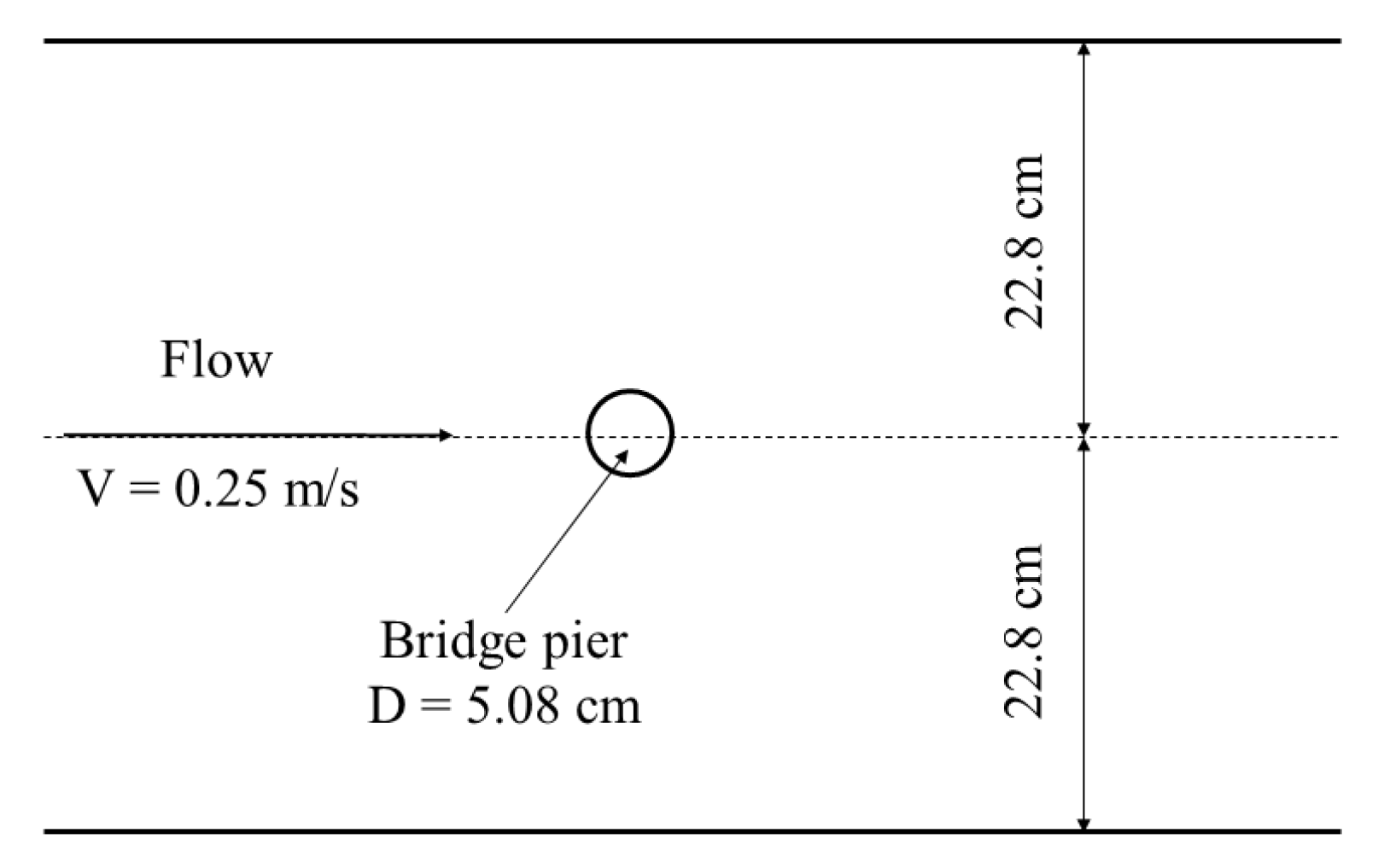
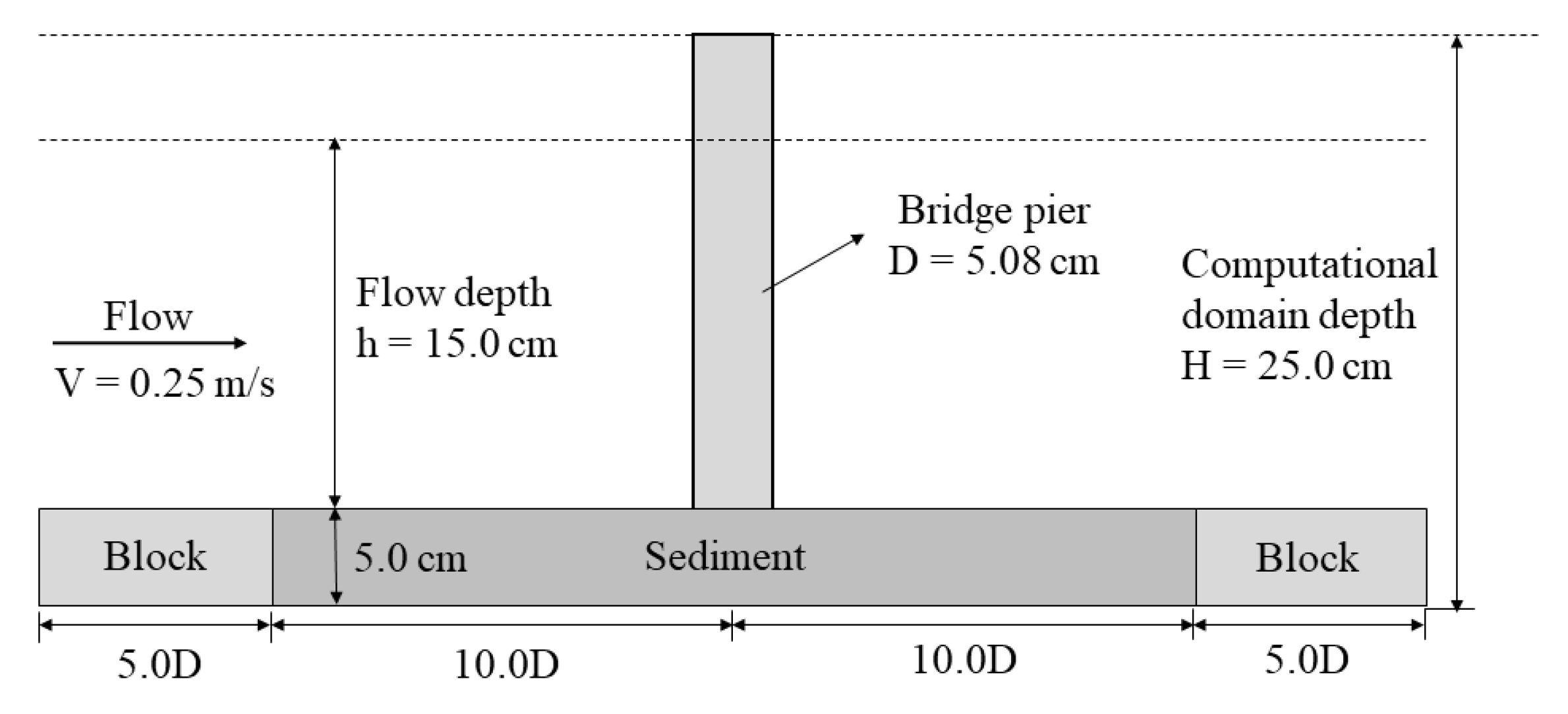
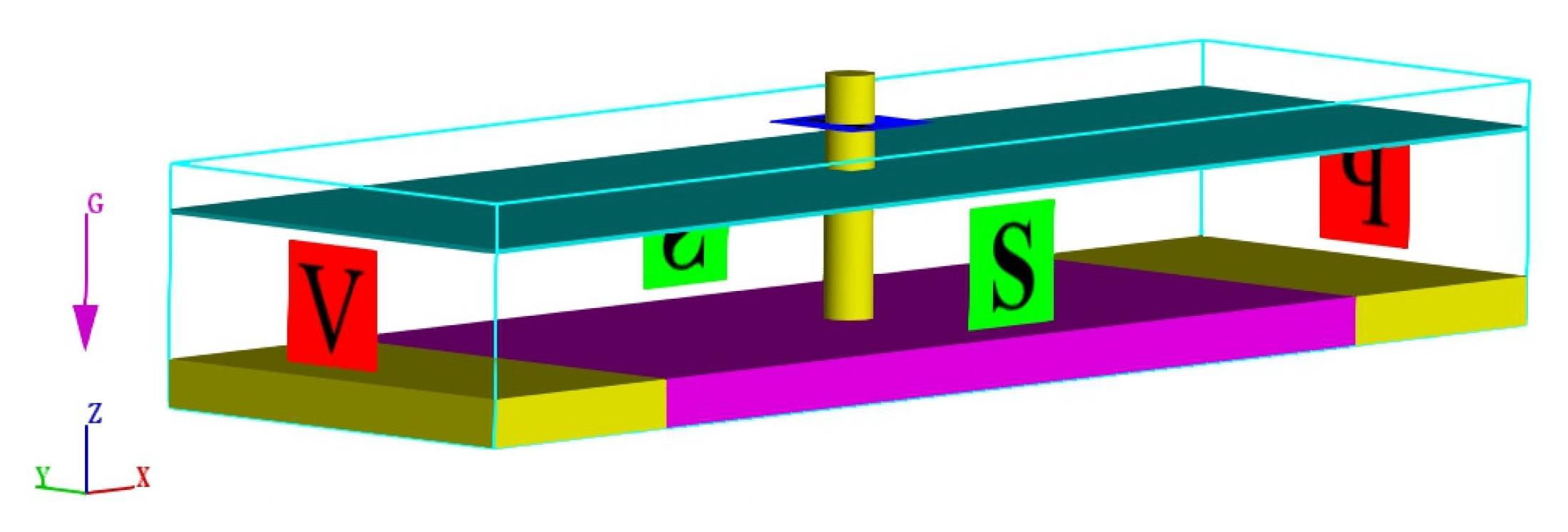

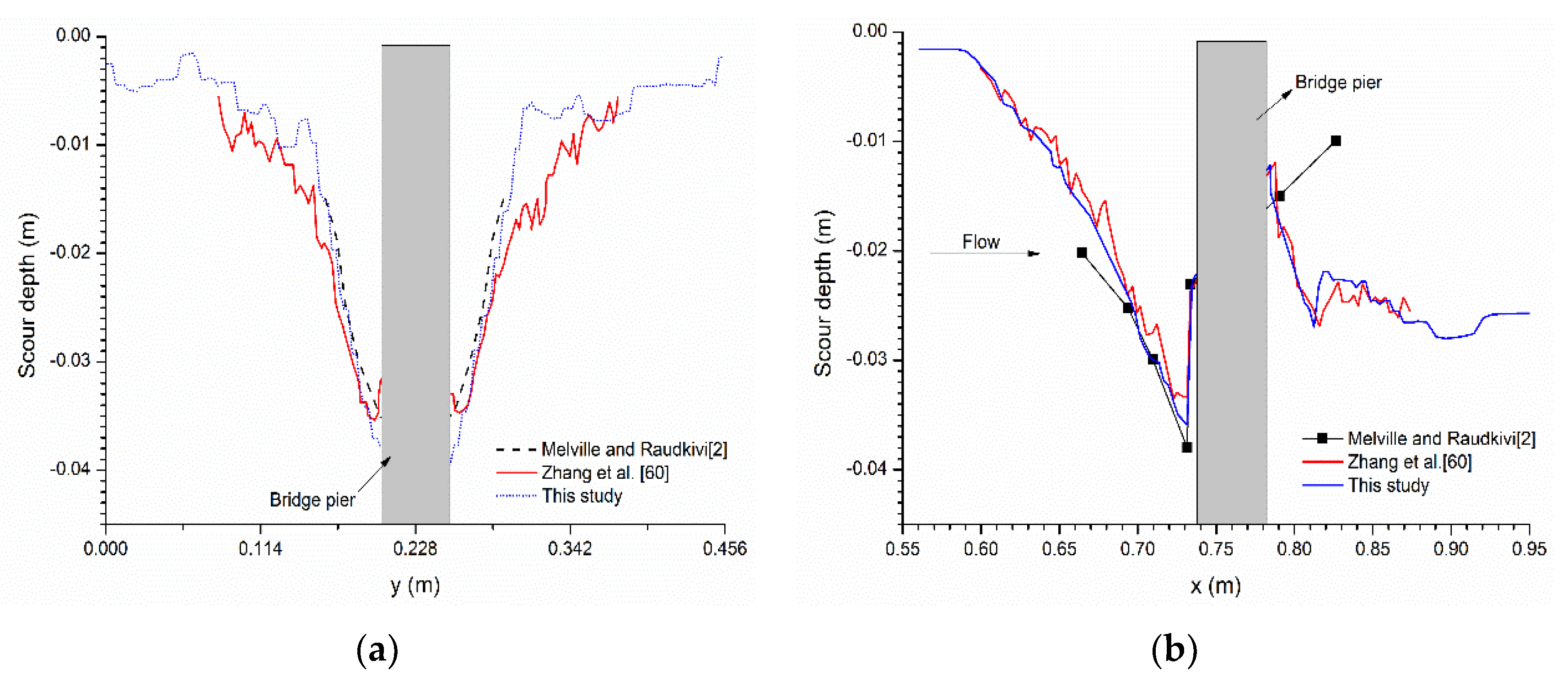

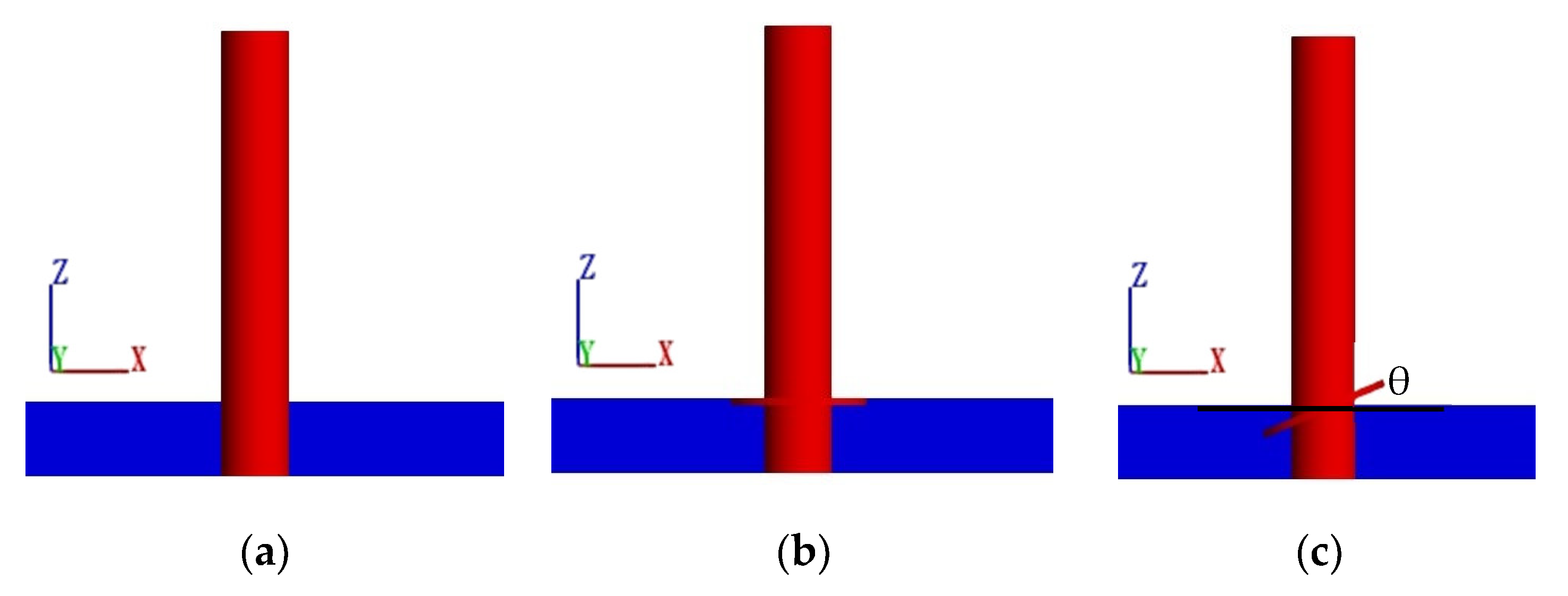
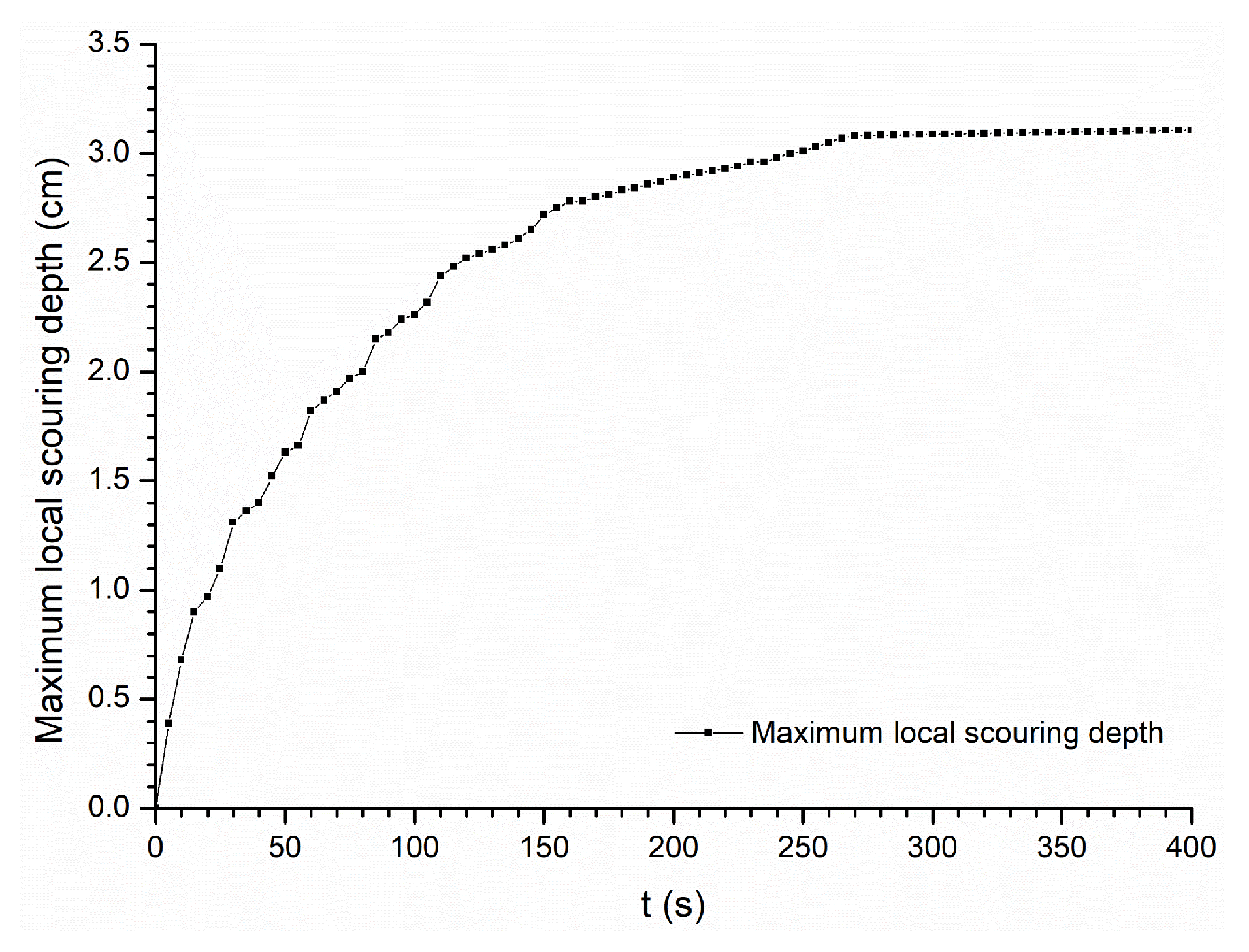
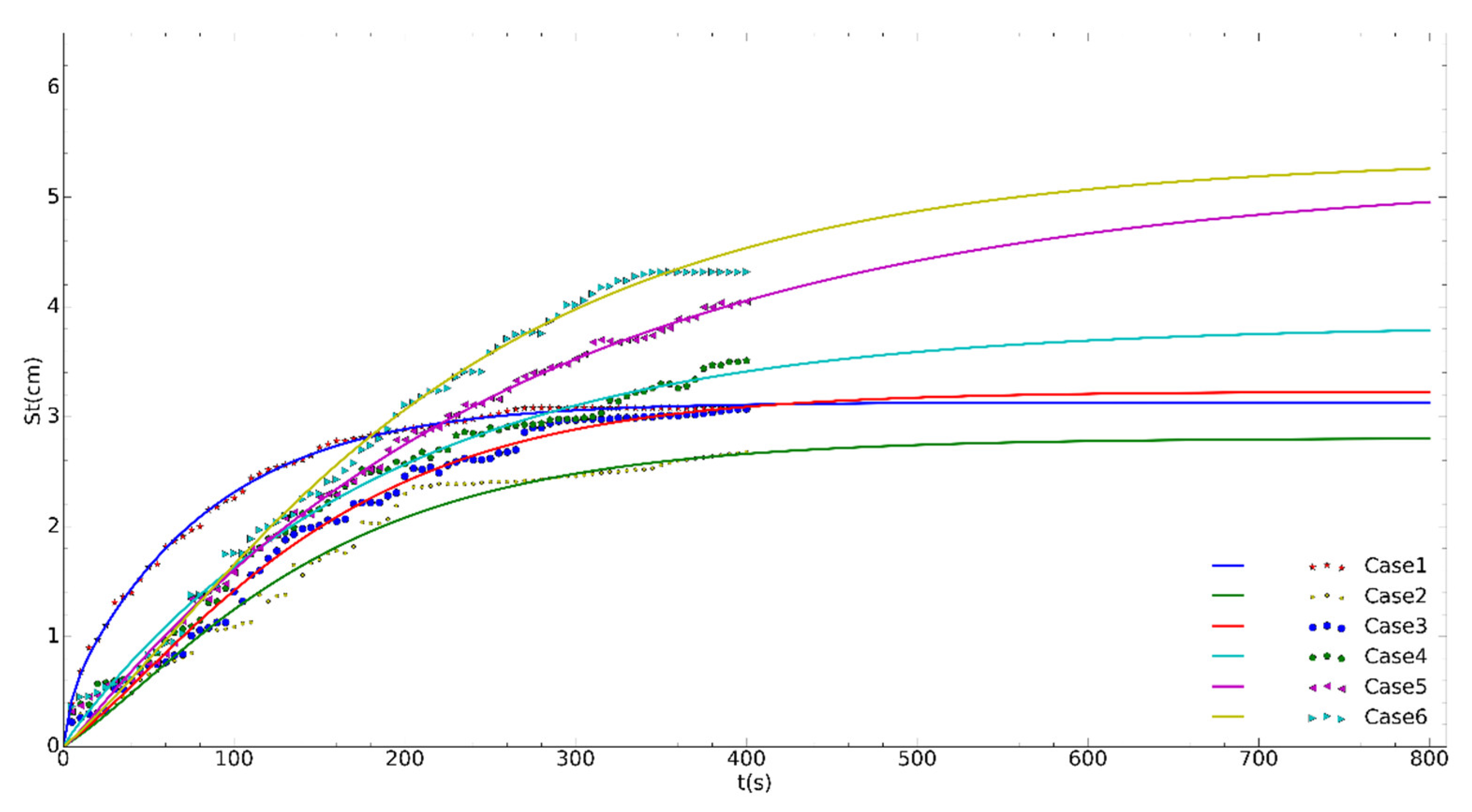
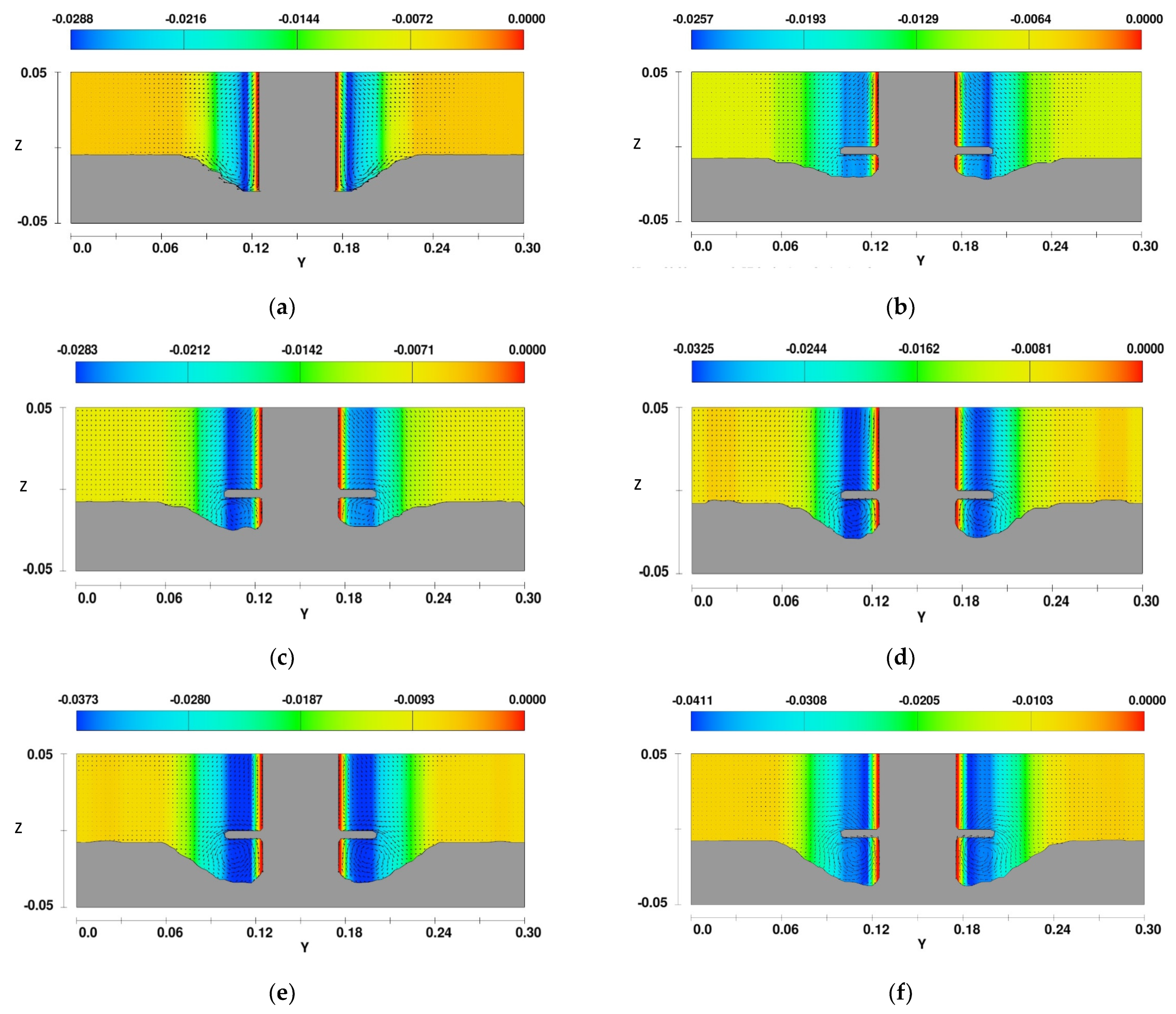
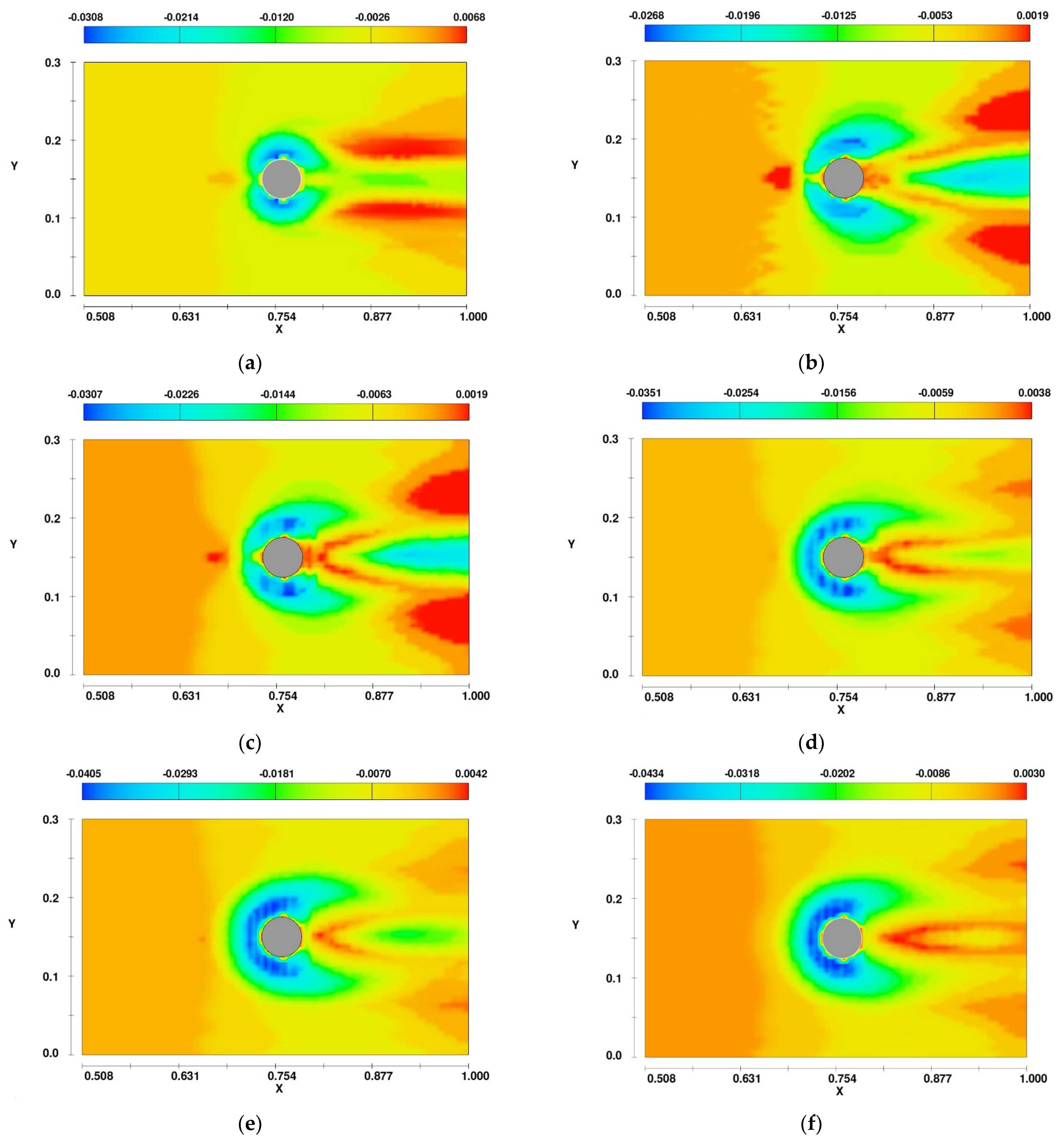
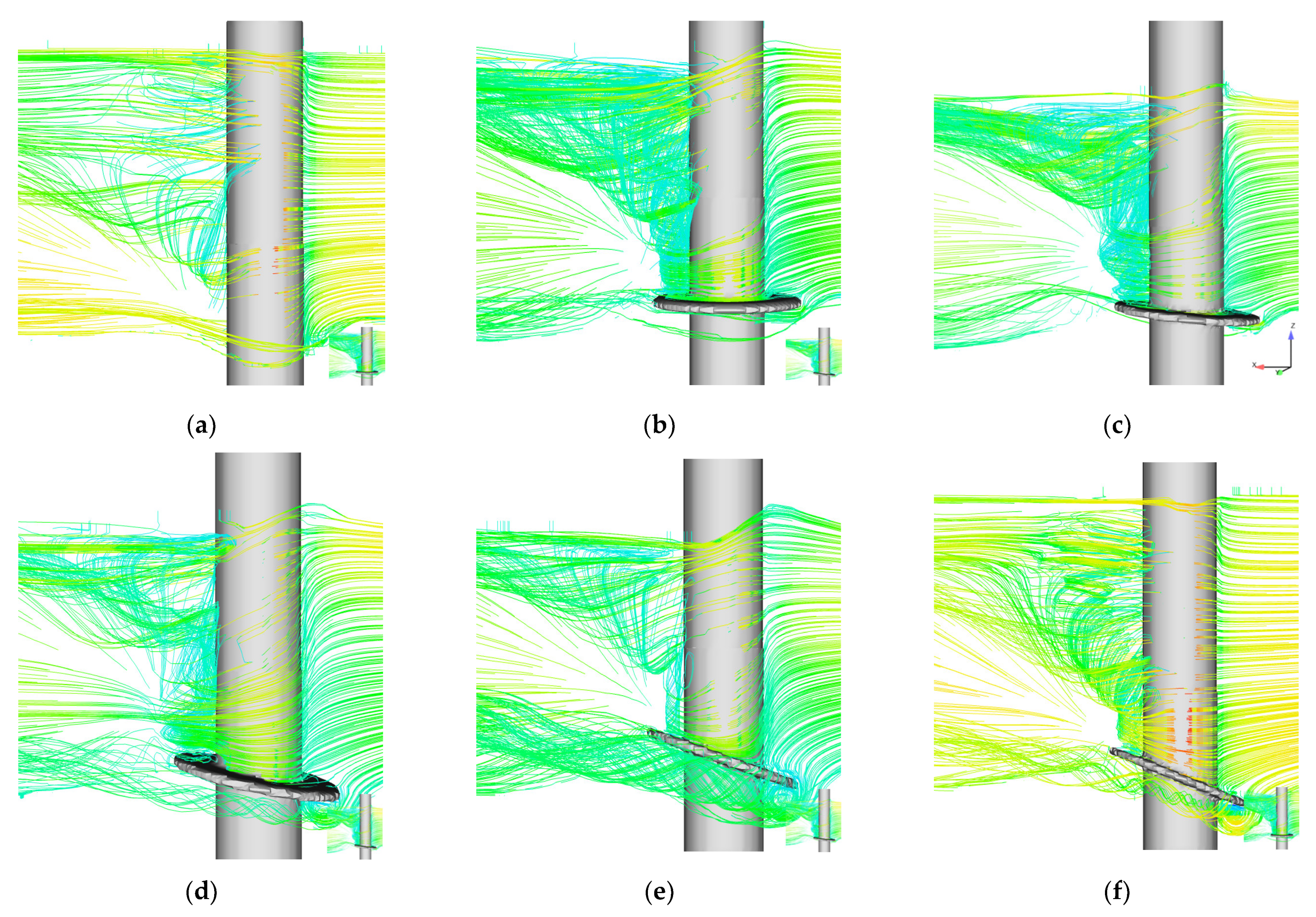
| Parameters | Critical Shield Number | Entrainment Coefficient | Bedload Coefficient | Bed Roughness | Static Angle of Repose (°) |
|---|---|---|---|---|---|
| Values | 0.033 | 0.018 | 8 | 2.5d50 | 32 |
| Case | 1 | 2 | 3 | 4 | 5 | 6 |
|---|---|---|---|---|---|---|
| Tilt angles of the circular collar (θ) | Without circular collar | 0° (horizontal) | 5° | 10° | 15° | 20° |
| Cases | a | b | c | d | Correlation Coefficient |
|---|---|---|---|---|---|
| 1 | 2.7463 | 0.0121 | 0.3846 | 0.2257 | 0.9998 |
| 2 | 3.8053 | 0.0082 | −0.9999 | 0.0215 | 0.9925 |
| 3 | 6.2384 | 0.0094 | −3.0090 | 0.0157 | 0.9968 |
| 4 | 3.8130 | 0.0055 | 0.0213 | 0.3054 | 0.9954 |
| 5 | 5.2669 | 0.0038 | −0.0575 | 0.2281 | 0.9980 |
| 6 | 6.6349 | 0.0052 | −1.2693 | 0.0170 | 0.9976 |
Publisher’s Note: MDPI stays neutral with regard to jurisdictional claims in published maps and institutional affiliations. |
© 2021 by the authors. Licensee MDPI, Basel, Switzerland. This article is an open access article distributed under the terms and conditions of the Creative Commons Attribution (CC BY) license (https://creativecommons.org/licenses/by/4.0/).
Share and Cite
Qi, H.; Tian, W.; Zhang, H. Modeling Local Scour around a Cylindrical Pier with Circular Collar with Tilt Angles (Counterclockwise around the Direction of the Channel Cross-Section) in Clear-Water. Water 2021, 13, 3281. https://doi.org/10.3390/w13223281
Qi H, Tian W, Zhang H. Modeling Local Scour around a Cylindrical Pier with Circular Collar with Tilt Angles (Counterclockwise around the Direction of the Channel Cross-Section) in Clear-Water. Water. 2021; 13(22):3281. https://doi.org/10.3390/w13223281
Chicago/Turabian StyleQi, Hongliang, Weiping Tian, and Haochi Zhang. 2021. "Modeling Local Scour around a Cylindrical Pier with Circular Collar with Tilt Angles (Counterclockwise around the Direction of the Channel Cross-Section) in Clear-Water" Water 13, no. 22: 3281. https://doi.org/10.3390/w13223281
APA StyleQi, H., Tian, W., & Zhang, H. (2021). Modeling Local Scour around a Cylindrical Pier with Circular Collar with Tilt Angles (Counterclockwise around the Direction of the Channel Cross-Section) in Clear-Water. Water, 13(22), 3281. https://doi.org/10.3390/w13223281






